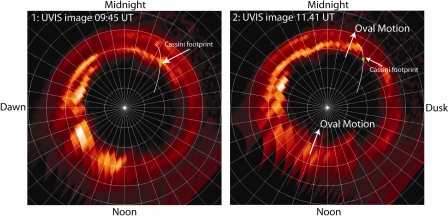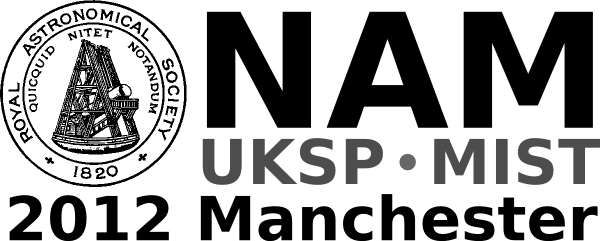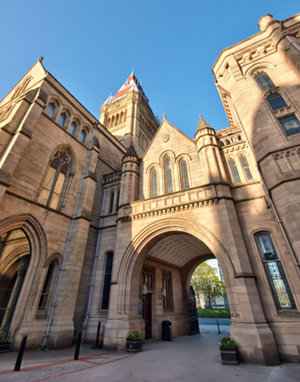UK-Germany National Astronomy Meeting NAM2012
Cassini makes simultaneous measurements of Saturn's nightside aurora and electric current system
Royal Astronomical Society press release
RAS PR 12/27 (NAM 18)
Tuesday 27 March 2012

Two images of Saturn's northern auroral oval, made with the Ultraviolet Imaging Spectrometer (UVIS) instrument. The second image, made two hours after the first, shows the motion of the oval as the planet rotates. (Click for a high-resolution version) Credit: NASA / ESA and the Cassini UVIS team
Since the NASA / ESA Cassini-Huygens spacecraft arrived at Saturn in 2004, astronomers and space scientists have been able to study the ringed planet and its moons in great detail. Now, for the first time, a team of planetary scientists have made simultaneous measurements of Saturn's nightside aurora, magnetic field, and associated charged particles. Together the fields and particle data provide information on the electric currents flowing that produce the emissions. Team leader Dr Emma Bunce of the University of Leicester will present the new work at the National Astronomy Meeting in Manchester on 27 March 2012.
Generally, images of the aurora (equivalent to the terrestrial 'northern lights') provide valuable information about the electromagnetic connection between the solar wind, the planet's magnetic field (magnetosphere) and its upper atmosphere. Variations in the aurora then provide information on changes in the associated magnetosphere. But viewing the aurora (best done at a large distance) at the same time as measuring the magnetic field and charged particles at high latitudes (where the aurora is found, best done close to the planet) is hard In 2009, Cassini made a crossing of the magnetic field tubes that connect to the aurora on the night side of Saturn. Because of the position of the spacecraft, Dr Bunce and her team were able to obtain ultraviolet images of the aurora (which manifests itself as a complete oval around each pole of the planet) at the same time. This is the first time it has been possible to make a direct comparison between Cassini images of the nightside aurora and the magnetic field and particle measurements made by the spacecraft. And because of the geometry of the orbit at Cassini, it took about 11 hours to pass through the high-latitude region or about the same time it takes Saturn to make one rotation. This meant that the team were able to watch the auroral oval move as the planet turned. As Saturn and its magnetosphere rotated, the auroral oval was tilted back and forth across the spacecraft with a speed that is consistent with a planetary rotation effect: Dr Bunce comments: "With these observations we can see the simultaneous motion of the electric current systems connecting the magnetosphere to the atmosphere, producing the aurora. Ultimately these observations bring us a step closer to understanding the complexities of Saturn's magnetosphere and its ever elusive rotation period".
IMAGE AND CAPTION
A high-resolution version of the image can be downloaded from https://www.ras.org.uk/images/stories/NAM/2012/uvis_image_small.jpg.
Caption: Two images of Saturn's northern auroral oval, made with the Ultraviolet Imaging Spectrometer (UVIS) instrument. The second image, made two hours after the first, shows the motion of the oval as the planet rotates. Credit: NASA / ESA and the Cassini UVIS team
MEDIA CONTACTS
NAM 2012 Press Office (0900 - 1730 BST, 27-29 March; 0900 - 1630 BST 30 March)
Room 3.214
University Place building
University of Manchester
Manchester
UK
Tel: +44 (0)161 306 7313
Dr Robert Massey
Royal Astronomical Society
Mob: +44 (0)794 124 8035
Email: rm@ras.org.uk
Anita Heward
Royal Astronomical Society
Mob: +44 (0)7756 034 243
Email: anitaheward@btinternet.com
Dr Klaus Jaeger
Pressereferent / Press Officer im Vorstand der Astronomischen Gesellschaft
Tel: +49 6221 528 379
Email: pressereferent@astronomische-gesellschaft.de
Dan Cochlin
Media Officer (Faculty of Engineering and Physical Sciences)
University of Manchester
Tel: +44 (0)161 275 8387
Email: daniel.cochlin@manchester.ac.uk
SCIENCE CONTACTS
Dr Emma Bunce
Department of Physics and Astronomy
University of Leicester
Tel: +44 (0)116 252 3541
Email: emma.bunce@ion.le.ac.uk
NOTES FOR EDITORS
NAM 2012
Bringing together more than 900 astronomers and space scientists, the National Astronomy Meeting (NAM 2012) will take place from 27-30 March 2012 in the University Place conference centre at the University of Manchester in the UK. The conference is a joint meeting of the Royal Astronomical Society (RAS) and the German Astronomische Gesellschaft (AG) and is held in conjunction with the UK Solar Physics (UKSP: www.uksolphys.org) and Magnetosphere Ionosphere Solar Terrestrial (MIST: www.mist.ac.uk) meetings. NAM 2012 is principally sponsored by the RAS, AG, STFC and the University of Manchester.
The Royal Astronomical Society
The Royal Astronomical Society (RAS: www.ras.org.uk), founded in 1820, encourages and promotes the study of astronomy, solar-system science, geophysics and closely related branches of science. The RAS organises scientific meetings, publishes international research and review journals, recognizes outstanding achievements by the award of medals and prizes, maintains an extensive library, supports education through grants and outreach activities and represents UK astronomy nationally and internationally. Its more than 3500 members (Fellows), a third based overseas, include scientific researchers in universities, observatories and laboratories as well as historians of astronomy and others.
The Astronomische Gesellschaft (AG)
The Astronomische Gesellschaft (AG: www.astronomische-gesellschaft.de), founded in 1863, is a modern astronomical society with more than 800 members dedicated to the advancement of astronomy and astrophysics and the networking between astronomers. It represents German astronomers, organises scientific meetings, publishes journals, offers grants, recognises outstanding work through awards and places a high priority on the support of talented young scientists, public outreach and astronomy education in schools.
The Science and Technology Facilities Council
The Science and Technology Facilities Council (STFC: www.stfc.ac.uk) is keeping the UK at the forefront of international science and tackling some of the most significant challenges facing society such as meeting our future energy needs, monitoring and understanding climate change, and global security. The Council has a broad science portfolio and works with the academic and industrial communities to share its expertise in materials science, space and ground-based astronomy technologies, laser science, microelectronics, wafer scale manufacturing, particle and nuclear physics, alternative energy production, radio communications and radar. It enables UK researchers to access leading international science facilities for example in the area of astronomy, the European Southern Observatory.
Jodrell Bank Centre for Astrophysics
The Jodrell Bank Centre for Astrophysics (JBCA: www.jb.man.ac.uk) is part of the School of Physics & Astronomy at the University of Manchester. JBCA is split over two main sites: the Alan Turing Building in Manchester and the Jodrell Bank Observatory in Cheshire. At Jodrell Bank Observatory, the new Jodrell Bank Discovery Centre is a key focus for our work in public engagement and education. Jodrell Bank is a world leader in radio astronomy-related research and technology development with a research programme extending across much of modern astrophysics. The group operates the e-MERLIN national radio astronomy facility and the iconic Lovell Telescope, hosts the UK ALMA Regional Centre Node and is home to the international office of the SKA Organisation. Funded by the University, the Science & Technology Facilities Council and the European Commission, it is one of the UK's largest astrophysics research groups.





